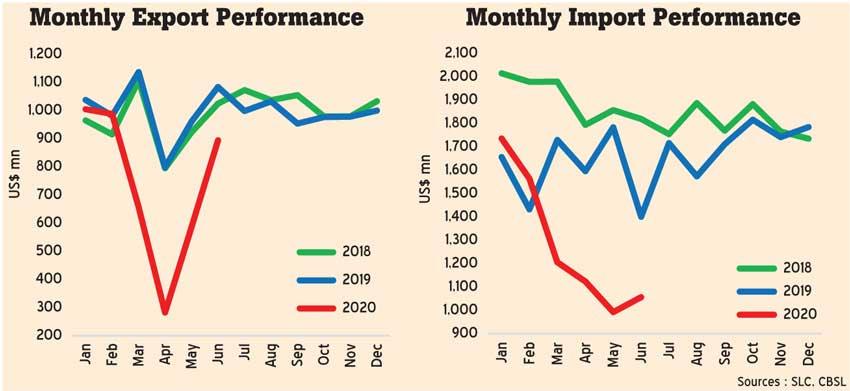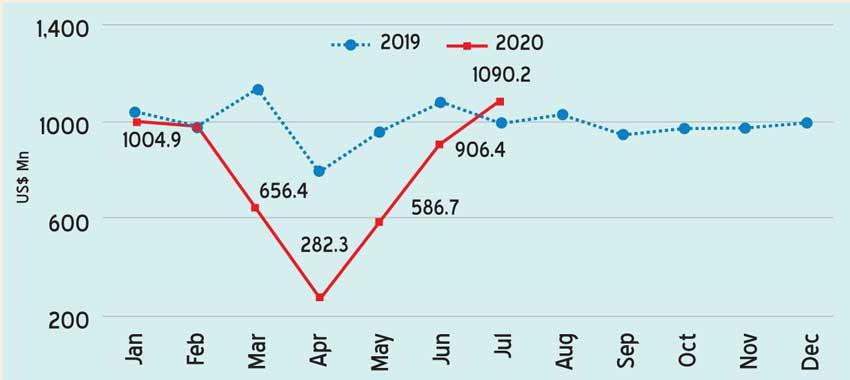17 Aug 2020 - {{hitsCtrl.values.hits}}

Sri Lanka’s trade deficit fell to US$ 161 million in June compared to US$ 316 million in the same month last year, recording the lowest monthly deficit in the country’s merchandise trade since August 2009 as exporters continued to push ahead while the imports plummeted.
Sri Lanka exported US$ 894 million worth goods in June staging a 52 percent growth from the US$ 587 million earned a month ago reflecting a quicker ‘V shaped’ recovery in the sector following the pandemic, the official data released by the Central Bank showed.
Imports fell by nearly a quarter to US$ 1,055 million led by a slump in the fuel bill, lower textiles and related articles used in manufacturing garments and non-essential commodities, which were restricted to stem undue pressure on the currency.
However, textiles and garments led the surge in exports from May as they quickly switched to manufacturing of personal protective equipment (PPE) such as facemasks and protective suits for their major clients in the United States and the Europe. Yet, the earnings from exports were still 17.5 percent from a year ago, as earnings from PPE could not make up for the lost sales of regular clothing items, as many physical stores worldwide remained closed for most of the period. In June, earnings from textiles and garments exports recorded US$ 403.7 million, up from US$ 219 million in May, but down 20 percent from the same month last year.
This is reflected in the import expenditure on textiles and textile articles, which was US$ 175.7 million in June, down 22.5 percent form the same month last year, as factories imported less fabric and yarn. This, coupled with the US$ 110.4 million oil bill, which was 61 percent lower than the US$ 285 million bill in the same month, last year had the largest effect on bringing the June trade deficit down to the lowest level seen in 11 years.
The lower oil bill was possible due to lower refined and crude oil import volumes and the slump in their prices caused by the glut in the global oil market during the pandemic as travel, industrial and other economic activities came to a standstill.
The other areas, which helped a lower trade deficit were the substantially lower expenditure on machinery and equipment, building materials and base metals. Sri Lanka’s construction sector restarted its operations in early June while restrictions have been imposed on some construction related items.
Meanwhile, agricultural exports staged a strong rebound in June, increasing by 12 percent from last year to US$ 229.1 million, marking the highest increase since May 2019.
The agricultural export earnings were held firm by all subcategories except for unmanufactured tobacco. Rubber, coconut, spices, vegetables, minor agricultural products and seafood grew by double digits.
Earnings from tea, Sri Lanka’s largest export agricultural commodity in June, recorded 1.6 percent growth to US$ 114.9 million driven by higher average prices. But the volumes recorded a minor decline.
Meanwhile, personal vehicle imports fell by 81 percent from a year ago to US$ 9.2 million in June while expenditure on home appliances such as refrigerators and television sets declined by 49 percent to US$ 6.3 million as the Central Bank imposed import restrictions on vehicle and other non-essential consumer goods to contain the pressure on the currency.
However, the import expenditure of food and beverages rose by 4.4 percent from a year ago to US$ 101.9 million in June with dairy products, vegetables, seafood and spices having recorded double digit increases.
On a cumulative basis, Sri Lanka’s exports for the first six months fell by 26.4 percent to US$ 4.4 billion while imports fell 20 percent to US$ 7.7 billion, enabling the country to contain the deficit on its merchandise trade account to US$ 3.3 billion from US$ 3.6 billion in the comparable period in 2019.

Further extending the gains made in export trade, Sri Lanka has recorded US$ 1,090.18 million in export earnings for July, repeating a feat made in January this year before the pandemic strained the trade flows across countries, the data collected by Sri Lanka Customs and compiled by Export Development Board, showed.
July exports also registered 11.31 percent increase from the same month last year, the first time the country’s exports surpassed the comparable month’s earnings after several months of lower exports caused by the pandemic.
Sri Lanka’s merchandise exports have made a robust recovery since May with the easing of restrictions on movement of people and operations of commercial and industrial activity pointing to a quicker ‘V-shaped’ recovery in the trade.
The July export earnings also marked 20.3 percent increment from the month earlier as month-on-month gains have been stronger since May.
“We have witnessed a phenomenal increase in exports in July 2020 with a new record for the year,” said EDB Chairman Prabhash Subasinghe.
However, Subasinghe cautioned about a possible resurgence of the virus in the United States and Europe towards the year-end.
The US stood as the largest customer of Sri Lankan made goods accounting for US$ 256 million worth goods exported in July, up 5.67 percent from US$ 242 million in June.
Meanwhile, the top commodities in July were textiles and garments, which recorded US$ 467 million, up 16.2 percent from June. Earnings from tea exports amounted US$ 131 million, which rose for the second consecutive month mainly due to the demand from Turkey and Russia.
Meanwhile personal protective equipment (PPE) related exports such as facemasks, protective suits and surgical gloves, connected to both apparel and rubber based products, recorded US$ 115.1 million in July. The July exports earnings bring the cumulative exports to US$ 5.5 billion from January through July compared to US$ 6.9 billion in the comparable period last year, the EDB data showed.
The EDB revised down the 2020 merchandise export earnings target to US$ 7.5 billion due to the pandemic, and the first seven months earnings demonstrate 72.5 percent achievement of the target.
The services sector export earnings estimated by the EDB, which include ICT/BPM, construction, financial services, transport & logistics and wellness tourism, amounted to US$ 2,044.6 million for the period of January-July 2020 compared to US$ 2,364.7 million recorded for the corresponding period of the previous year.
“However, estimated service exports declined by 13.53 percent during the period of January-July 2020 compared with the corresponding period of previous year,” the EDB noted.
18 Nov 2024 14 minute ago
18 Nov 2024 19 minute ago
18 Nov 2024 25 minute ago
18 Nov 2024 50 minute ago
18 Nov 2024 52 minute ago